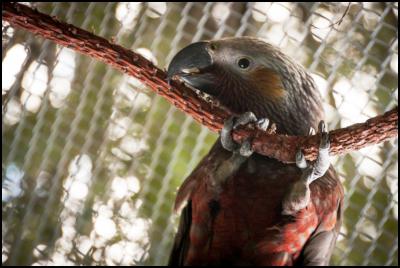Te Anau Wildlife Centre welcomes kākā and farewells kea
Te Anau Wildlife Centre welcomes kākā and farewells kea

Te Anau Wildlife Centre is
set to join the Department of Conservation’s kākā
captive breeding programme after the resident birds have
successfully reared chicks this summer.
In previous seasons the kākā, Charlie Brown and Bling, had attempted to breed but never managed to nest successfully. This season they successfully hatched their eggs and the three chicks have all been reared to adolescence.
A new breeding facility more suited to nesting and rearing chicks will be made for the kākā by modifying the current kea enclosure.
The chicks from the Te Anau Wildlife Centre will be released into Orokonui Eco-sanctuary, near Dunedin, once they are fully grown.
Andrew Smart, DOC biodiversity ranger, is excited that the kākā reared at the Wildlife Centre will be contributing to the conservation of their species.
“It is great to see the Centre’s kākā raising chicks that will boost newly established populations in areas where restoration work is being done.”
While the Wildlife Centre has welcomed the arrival of the kākā chicks, they are now set to farewell another inhabitant, as the solitary female kea will soon be moving to a new home.
The Wildlife Centre does not meet DOC’s current standards for holding captive kea; the enclosure does not meet specifications and kea must not be keep alone. Kea are highly intelligent and social birds and need the stimulation provided by companions.
The kea will be moved to Wellington Zoo, for a period of quarantine, before joining captive kea, either at Willowbank Wildlife Reserve or Orana Wildlife Park near Christchurch.
When it was revealed last year that DOC was reviewing holding kea and kākā at the Wildlife Centre, the Te Anau community expressed concern about the possibility of these birds being moved.
DOC Fiordland Conservation Services Manager, Lindsay Wilson, said DOC recognises that the future of Te Anau Wildlife Centre and its inhabitants is important to the local community.
“We appreciate the level of concern and feedback we have received about the Wildlife Centre’s future. This shows the level of passion and commitment Te Anau locals have for wildlife and conservation.”
Four takahē also reside at the Te Anau Wildlife Centre and DOC is committed to maintaining this display population.
The Centre’s facilities are also used by the Pāteke Recovery Group for housing pāteke/brown teal breeding pairs, and periodically by the Whio Recovery Group to rear whio/blue duck ducklings.
–Ends–
Display sites such as the Te
Anau Wildlife Centre play an important role in Takahē
Recovery by offering a home to retiring or non-breeding
birds thus freeing up territory at secure sites, such as
Burwood Bush, for more productive pairs of takahē.
It also gives both local, and overseas, visitors the chance to view these critically endangered birds
PĀTEKE
DOC is currently involved in a programme which breeds pāteke and releases them into the wild to establish new populations. Te Anau Wildlife Centre currently houses three breeding pāteke pairs.
WHIO/BLUE DUCK
The Te Anau Wildlife Centre is used as a captive rearing facility for juvenile whio in years when conditions are favourable to remove eggs from wild breeding pairs to rear in captivity.
ends


 Business Canterbury: Urges Council To Cut Costs, Not Ambition For City
Business Canterbury: Urges Council To Cut Costs, Not Ambition For City Wellington Airport: On Track For Net Zero Emissions By 2028
Wellington Airport: On Track For Net Zero Emissions By 2028 Landcare Research: ANZAC Gall Fly Release Promises Natural Solution To Weed Threat
Landcare Research: ANZAC Gall Fly Release Promises Natural Solution To Weed Threat NZ Anti-Vivisection Society: Auckland Rat Lovers Unite!
NZ Anti-Vivisection Society: Auckland Rat Lovers Unite! University of Canterbury: $1.35 Million Grant To Study Lion-like Jumping Spiders
University of Canterbury: $1.35 Million Grant To Study Lion-like Jumping Spiders Federated Farmers: Government Ends War On Farming
Federated Farmers: Government Ends War On Farming



